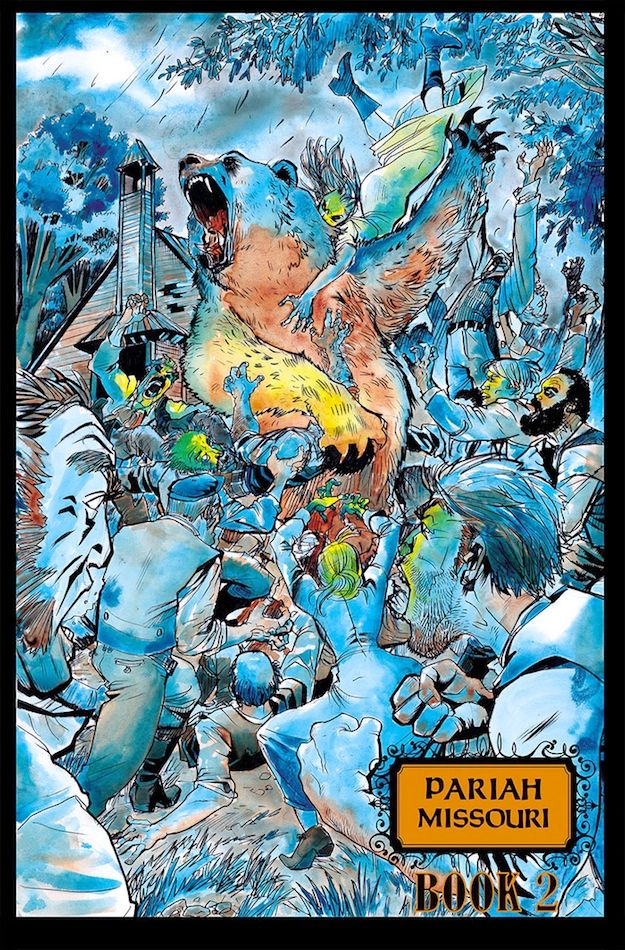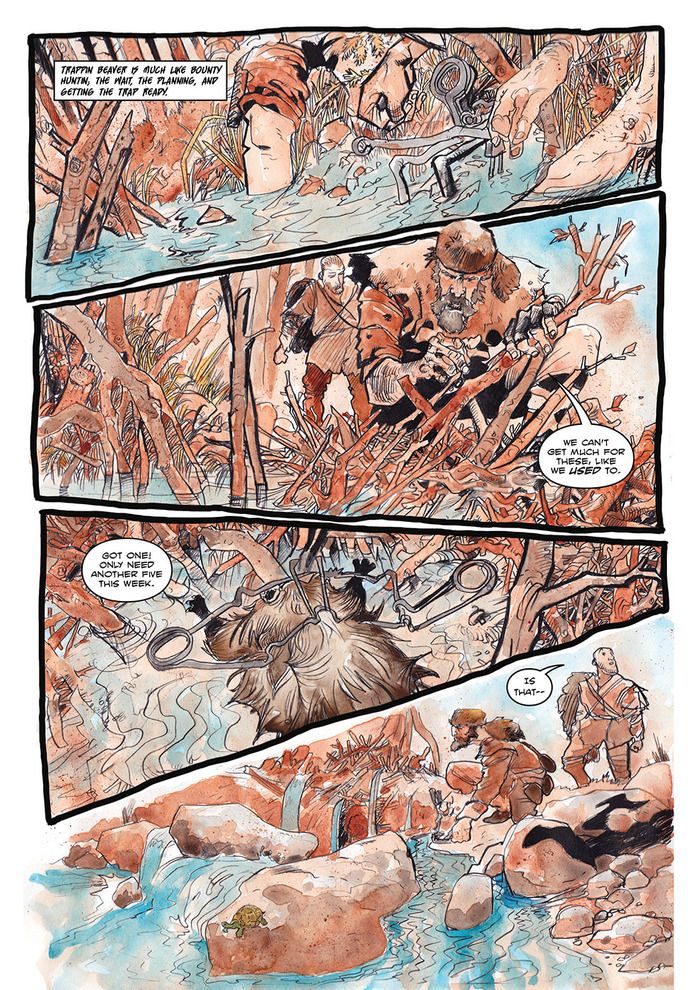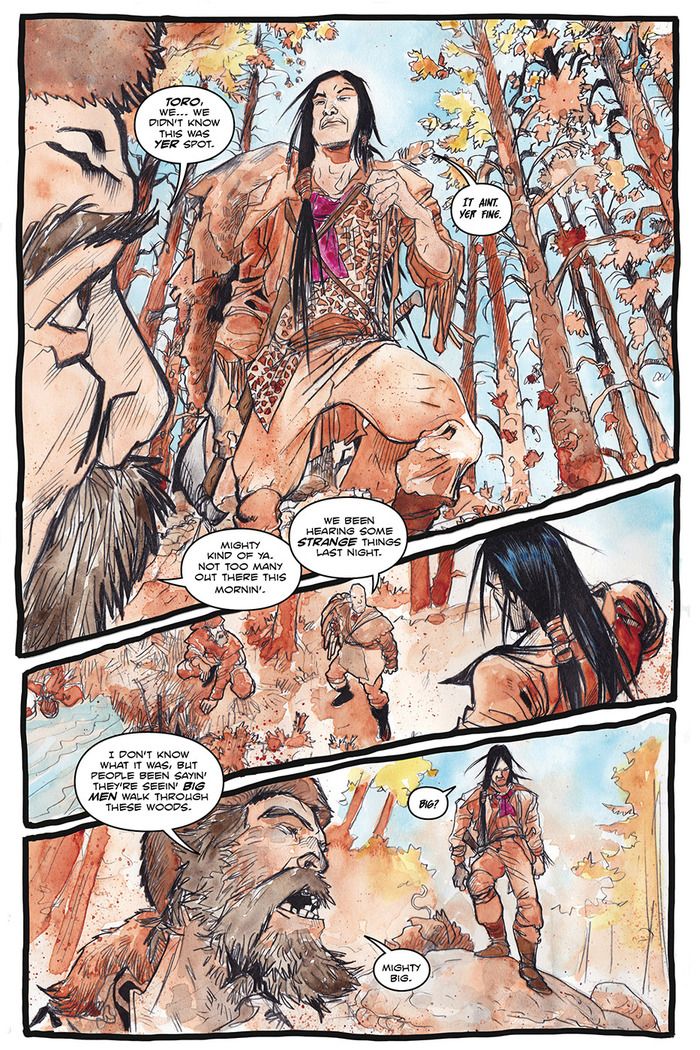Writer Andres Salazar puts a cool spin on the supernatural Western genre in Pariah, Missouri: The town itself anchors the book — Salazar calls it the "main character" — and he uses it as a vantage point to watch the comings and goings of an amazingly varied cast of characters, some with supernatural powers. He and artist Jose Pescador lay out the territory in Book 1, and assemble a sort of 19th-century Mod Squad to fight the forces of evil.
Salazar crowdfunded the first volume of Pariah, Missouri, on Kickstarter, and Diamond Comic Distributors picked it up for July Previews — in fact, it was a Staff Pick—and it's available in comic shops now. He's running a Kickstarter campaign to fund the second volume.
Robot 6: What is it about this particular time and place that intrigued you?
Andres Salazar: I wanted something different than a traditional Western, which are post-Civil War stories, usually in the 1880s, after the trains crossed the plains. I wanted it to be in the 1850s, when slavery was still present. Missouri had a unique position in the country as having both slaves and free blacks, so I wanted to explore those social dynamics. I grew up in Arkansas and traveled to Missouri many times, and there's something special about the Midwest that I wanted to explore. It was the frontier in the 1850s, and a hotbed of various religions and folk magic. Lastly, I'm a fan of Mark Twain and his stories on the steamboats, and I wanted Pariah to be that mysterious steamboat boomtown.
In the back of the first volume, you have a page of photos of people from the 19th century. Who are they, and how do they relate to the characters in this book?
Some of those photos are actually my family members. I've done a lot of genealogy and family-history research, and used some of their photos. Each one of those photos represents one of the main characters in the book; the idea is to visually show how there are connected to Marshal Cody, who is missing from Book 1. It also gave the idea that Pariah is a documentary of sorts and that this is real (which of course it is not). People really like the family tree poster. There was something that I found strange about making it: I made it after Jose started working on the pencils and he later saw how similar some of his drawings were to the photographs in the book, we were a little creeped out by that.
Your story departs a bit from the standard Western format in that it has a pretty diverse cast of leading and supporting characters. Why is that, and what was your thought process as you created these characters?
My stories are always character-centric. Pariah is the main character, like Twin Peaks, where the location takes center stage. The story is about this town and these pioneers, farmers, gamblers and killers all connected together trying to build something out in the farthest point west. Each of these characters in the book has a motivation, a dream and history of pain and suffering. I also wanted a "team-book," another departure from the traditional Western, where a motley crew comes together to save the town. I took ideas from history and various professions and belief-systems to make this melting-pot environment.
Your storytelling is a bit elliptical — we don't get the full details all at once, although things are hinted at. Why do you like telling stories that way?
Because of the long-term plans I have in the series, I needed to lay down a lot of background on the town and characters. It's a slow burn at first, but I think it helps you understand the setting. I love stories that get you thinking and that place clues in the book, which you can go back and re-discover. That's probably why I loved making the deluxe hardcovers, which have my commentary on every page; I talk about the process of making the story, the individual scenes and interpretations of dialog.
Can you describe the process of creating this comic? Did you do a lot of research?
I research, mucho. I read books on the early 1800s, some Civil War books and books on folk magic and religions of the times. I start writing character arcs, and I have this large wall that breaks down the characters and scenes, like something you would see in a TV writers' room, and I go from there. Each act is broken down and I start getting scenes together. I write the script in scenes like a screenplay and then start converting it into comic book pages, which is another big job. Rewrites. Rewrites again and send it to Jose with reference photos, drawings and my page breakdowns. He does his magic, I make touch-ups, maybe change a few things and ink it, watercolor paint it and start doing the lettering. Here in the post-art phases I go back to the script and rewrite again, since usually it's been a number of months since I've read the script and improvements come to mind. In Book 2 there are some new scenes that I asked Jose to draw because I found there was a plot point that wasn't connecting well, so it can be another creative cycle at the very end of creating the book.
It looks like Jose pencils the comic and you do the inking and coloring. How does that work? Do you give him thumbnails?
With the script I send him thumbnails of some of the pages. He uses some and improves others — he has a great dynamic style that fits perfectly. When I get the pencils, I make any modifications in the computer and print the pages to paint. I then paint and ink the book together; sometimes there is digital touch up after I paint.
You funded the first volume on Kickstarter, but it looks like that was a collection of five single issues. Were those published separately? How did you fund them?
The idea was that Book 1 was a five-act story, but I never intended to make five separate comic books. From a self-publishing standpoint, that would just not work for me. I did make Act 1 into a 24-page comic and printed about 50 copies, but that was to show to publishers and editors at conventions, hoping it would be picked up. I wanted to show companies that Jose and I were serious and had skin in the game to make books, so I printed those to hand out, but they were never sold to the public.
Why did you do two different Kickstarters for Vol. 1?
The first Kickstarter I ever did was very scary. I didn't know how it would be received and if I would even make my goal. I decided I wanted it to be half of Book 1, since that's the point I was at in the process and I could get the book out to everyone quickly, and it also allowed me to be able to fund the rest of Book 1, which at 116 pages was expensive. I hate waiting for rewards, which are usually late, and I'm proud to say that my three successful Kickstarters I've done, ALL my rewards go out on-time, usually within one to two months after the project ends. The funds for the first Kickstarter paid for the art of Book 1.
Kickstarter #2 was the complete Book 1 trade and the deluxe hardcover. The oversized hardcovers are not sold at stores, only through the Kickstarter and face to face. They cost too much to print to use a distributor, which is unfortunate, because everyone loves them, it's over-sized, I include the commentary I mentioned before and also extra scenes, background on characters, location and my creative process. It's the blu-ray of the book.
What did you learn from your first Kickstarter?
I learned that Kickstarter is a viable method of making your book, is extremely stressful and you have very little control how well it does after a certain point. I loved interacting with fans and backers. I enjoyed building relationships with the press. It is very stressful for me though.
How are you distributing volume 1? How did you get Diamond to distribute it?
Book 1 can be purchased directly through me at www.pariahmissouri.com or decadebrothers.com. I also have the Kickstarter for Book 2 live now, as a Staff Pick, which you can get a copy of books 1 and 2 together. I am an exhibitor at many conventions on the West Coast, and I attend store signings. It can also be purchased at local shops, through Diamond. I spoke to a rep from Diamond, sent them the book, they loved it and added it as their staff pick for July.
What are your plans for Book 2? Is it a standalone graphic novel or have you published it as single issues as well?
Book 2 will be a graphic novel; there will not be single issues of it. I am 95% done with Book 2 and it should be going to the printers by Sept 26th. I am planning on shipping Book 2 in late October. People who enjoyed Book 1 will love Book 2. We continue the story and intrigue and heat things up as Hiram gets closer than he wants to the Syndicate. Nellie is our focus this book, and I'm excited to show a female as the main character and what real-life struggles she goes through. We also introduce Elijah Harris a preacher in Pariah, and his congregation, the Church of Golgotha — let's just say he doesn't "save" people the traditional way. At www.pariahmissouri.com you can download the first 13 pages of Book 1 and Book 2 to preview and see if it's your cup of tea.
Will there be more volumes after this one?
Heck, yeah! I'm going through Book 3 script now, getting the scenes together. The plan will be that Pariah is five volumes, culminating in the American Civil War. I'm hoping that we can get a book completed every 10 to 12 months. I have big scenes, arcs and a final image for the end of the story and I am completely excited about telling this story of the supernatural frontier of 1857.




